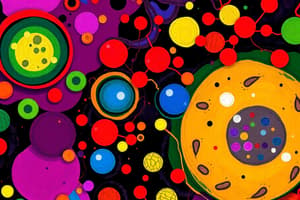Podcast
Questions and Answers
What is the primary component of thick filaments?
What is the primary component of thick filaments?
- Vimentin
- Keratin
- Myosin (correct)
- Actin
Which of the following best describes intermediate filaments?
Which of the following best describes intermediate filaments?
- They vary in type, with approximately 50 different types in humans. (correct)
- They are exclusively found in muscle cells.
- They are formed solely of actin.
- They are the largest filaments in the cytoskeleton.
In what form is carbohydrate usually stored within cells?
In what form is carbohydrate usually stored within cells?
- Fructose
- Glucose
- Glycogen (correct)
- Starch
Which of the following structures serves as the major site for lipid storage in the body?
Which of the following structures serves as the major site for lipid storage in the body?
What type of filament is formed from actin?
What type of filament is formed from actin?
Which of the following staining methods is used to visualize glycogen in tissues?
Which of the following staining methods is used to visualize glycogen in tissues?
Which type of intermediate filament is specifically found in epithelial cells?
Which type of intermediate filament is specifically found in epithelial cells?
Why can't lipids be demonstrated by standard H&E staining?
Why can't lipids be demonstrated by standard H&E staining?
What is one primary function of ribosomes in a cell?
What is one primary function of ribosomes in a cell?
Where are ribosomes primarily formed within the cell?
Where are ribosomes primarily formed within the cell?
Which type of ribosomes is associated with the rough endoplasmic reticulum (rER)?
Which type of ribosomes is associated with the rough endoplasmic reticulum (rER)?
What are microtubules primarily composed of?
What are microtubules primarily composed of?
How do microtubules change their length?
How do microtubules change their length?
Which part of the ribosome is occupied by the newly formed polypeptide chain?
Which part of the ribosome is occupied by the newly formed polypeptide chain?
What is the size range of ribosomes?
What is the size range of ribosomes?
Which form of ribosomes is primarily found in immature cells like stem cells?
Which form of ribosomes is primarily found in immature cells like stem cells?
What structure is responsible for the formation of cilia?
What structure is responsible for the formation of cilia?
Which of the following statements correctly describes centrioles?
Which of the following statements correctly describes centrioles?
What is the main function of cilia on the cell surface?
What is the main function of cilia on the cell surface?
Each centriole has a specific structure made up of microtubules. How many triplets of microtubules make up one centriole?
Each centriole has a specific structure made up of microtubules. How many triplets of microtubules make up one centriole?
What is the role of the basal body in cilia formation?
What is the role of the basal body in cilia formation?
Why are centrioles not found in non-dividing cells such as RBCs and nerve cells?
Why are centrioles not found in non-dividing cells such as RBCs and nerve cells?
Which component grows upward to form the shaft of a cilium?
Which component grows upward to form the shaft of a cilium?
How are cilia structurally important for their function?
How are cilia structurally important for their function?
Flashcards are hidden until you start studying
Study Notes
Cell Organelles
- Centrioles are small cylindrical structures found near the nucleus in an area called the centrosome.
- Centrioles are involved in cell division and the formation of cilia and flagella.
- Cilia are hair-like projections that move fluids and particles along the cell surface.
- Cilia develop from centrioles and consist of a shaft, a basal body, and rootlets.
- Flagella are long cilia that provide motility, such as the tail of a sperm cell.
- Filaments are thread-like structures that contribute to the cytoskeleton, maintaining cell shape.
- Microfilaments are thin filaments made of actin, found in muscle and microvilli.
- Intermediate filaments have a diameter of 8-10nm and come in various types found in different cell types.
- Thick filaments are made of myosin and are found in skeletal muscle.
Cell Inclusions
- Stored food includes carbohydrates and lipids.
- Carbohydrates are stored as glycogen in the liver and muscles.
- Lipids are stored as droplets or globules, primarily in fat cells.
- Pigments are colored substances found in cells.
Non-Membranous Cell Organelles
- Ribosomes are small organelles responsible for protein synthesis.
- Free ribosomes are scattered in the cytoplasm.
- Polyribosomes are groups of ribosomes connected by mRNA.
- Attached ribosomes are bound to the endoplasmic reticulum.
- Cytoskeleton is a network of filaments that gives the cell its shape and allows for movement.
- Microtubules are hollow tubes made of tubulin that provide structural support and participate in intracellular transport.
Studying That Suits You
Use AI to generate personalized quizzes and flashcards to suit your learning preferences.




